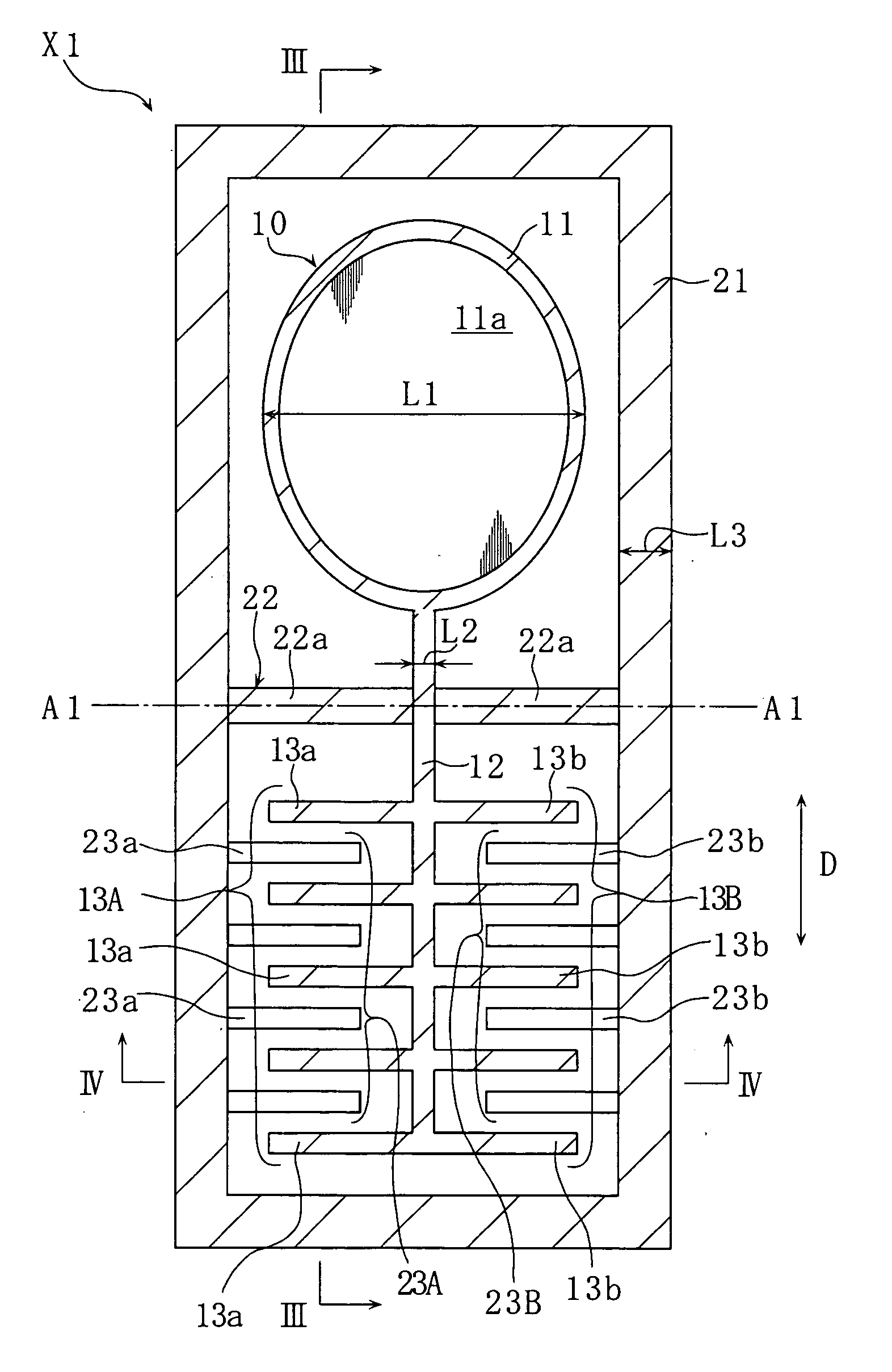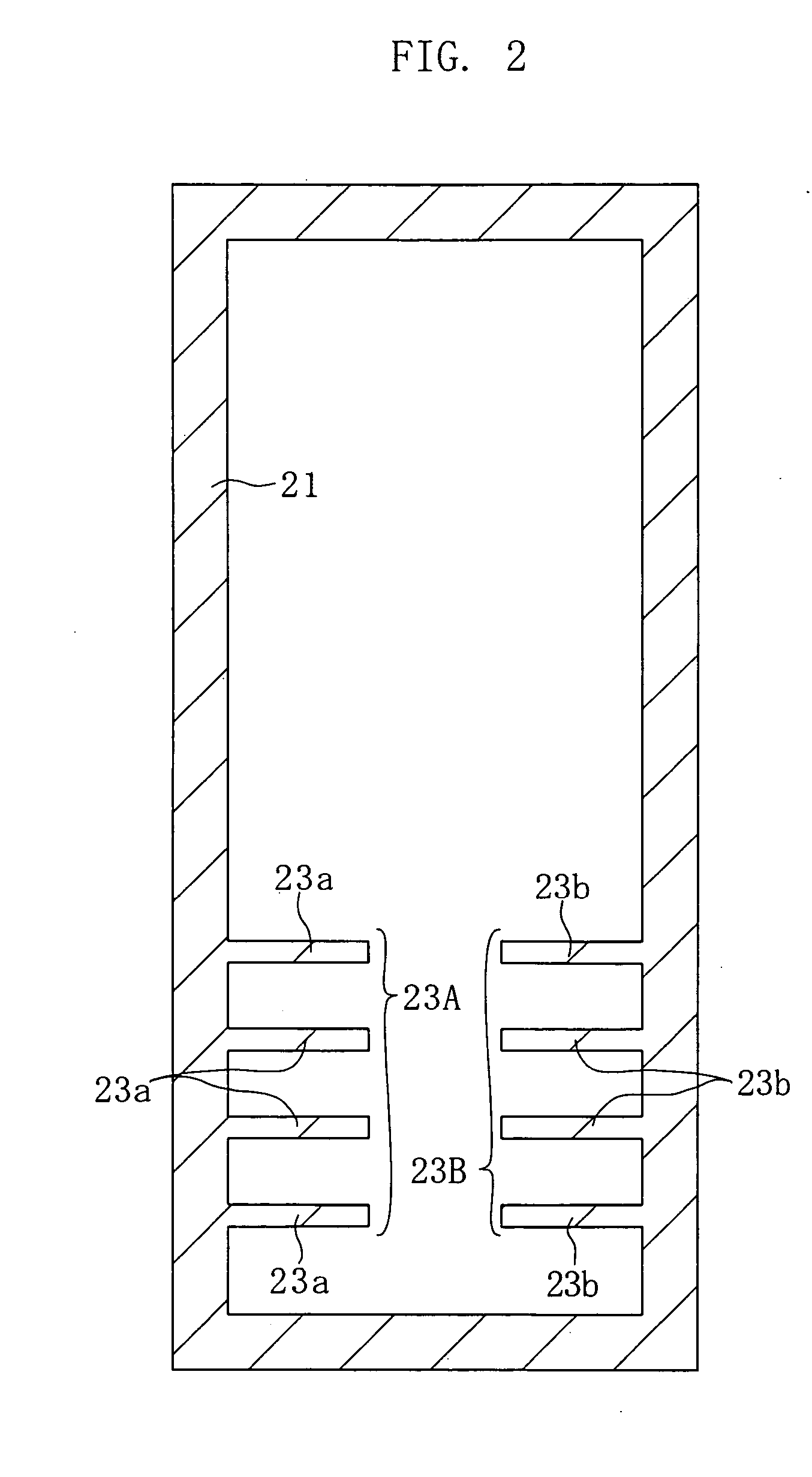Micro oscillating element
a technology of micro-oscillating elements and mirror surfaces, applied in the direction of optical elements, generators/motors, instruments, etc., can solve the problems of difficult to achieve a high degree of flatness on a mirror surface with a large surface area, thin mirror surface that is ultimately formed, and easy buckles
- Summary
- Abstract
- Description
- Claims
- Application Information
AI Technical Summary
Benefits of technology
Problems solved by technology
Method used
Image
Examples
first embodiment
[0059] FIGS. 1 to 4 show a micromirror element X1 according to the present invention. FIG. 1 is a plan view of the micromirror element X1, FIG. 2 is a partial plan view of the micromirror element X1, and FIGS. 3 and 4 are sectional views along a line III-III and a line IV-IV respectively.
[0060] The micromirror element X1 comprises an oscillation section 10, a frame 21, a torsional joining section 22, and comb-tooth electrodes 23A, 23B, and is manufactured using bulk micromachining technology, such as MEMS technology, by machining a material substrate, which is a so-called SOI (silicon on insulator) substrate. The material substrate has a laminated structure constituted of a first silicon layer and second silicon layer, and an insulation layer provided between the silicon layers. Each silicon layer is provided with a predetermined conductivity by means of impurity doping. The aforementioned various regions of the micromirror element X1 are mainly formed on the first silicon layer and...
second embodiment
[0100] FIGS. 15 to 18 show a micromirror element X2 pertaining to the present invention. FIG. 15 is a plan view of the micromirror element X2, FIG. 16 is a partial plan view of the micromirror element X2, and FIGS. 17 and 18 are sectional views along a line XVII-XVII and a line XVIII-XVIII of FIG. 15, respectively.
[0101] The micromirror element X2 comprises an oscillation section 10, a frame 24, a torsional joining section 22, and comb-tooth electrodes 23A, 23B. The micromirror element X2 differs from the micromirror element X1 in comprising the frame 24 instead of the frame 21. Further, the micromirror element X2 is manufactured by machining a material substrate, which is an SOI substrate, using the MEMS technology described above in relation to the micromirror element X1. The material substrate has a laminated structure comprising a first silicon layer, a second silicon layer, and an insulation layer between the silicon layers, each silicon layer being provided with a predetermine...
third embodiment
[0110] FIGS. 19 to 23 show a micromirror element X3 according to the present invention. FIG. 19 is a plan view of the micromirror element X3, FIG. 20 is a partial plan view of the micromirror element X3, and FIGS. 21 to 23 are sectional views along a line XXI-XXI, a line XXII-XXII, and a line XXIII-XXIII in FIG. 19, respectively.
[0111] The micromirror element X3 comprises an oscillation section 10′, a frame 25, a torsional joining section 22, and comb-tooth electrodes 23A, 23B. The micromirror element X3 differs from the micromirror element X1 in comprising the oscillation section 10′ in place of the oscillation section 10, and in comprising the frame 25 in place of the frame 21. Further, the micromirror element X3 is manufactured by machining a material substrate, which is an SOI substrate, using the MEMS technology described above in relation to the micromirror element X1. The material substrate has a laminated structure comprising a first silicon layer, a second silicon layer, an...
PUM
 Login to View More
Login to View More Abstract
Description
Claims
Application Information
 Login to View More
Login to View More - R&D
- Intellectual Property
- Life Sciences
- Materials
- Tech Scout
- Unparalleled Data Quality
- Higher Quality Content
- 60% Fewer Hallucinations
Browse by: Latest US Patents, China's latest patents, Technical Efficacy Thesaurus, Application Domain, Technology Topic, Popular Technical Reports.
© 2025 PatSnap. All rights reserved.Legal|Privacy policy|Modern Slavery Act Transparency Statement|Sitemap|About US| Contact US: help@patsnap.com



